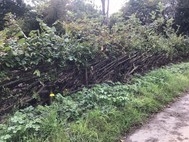Hedging your bets!

|
Britain lost half its hedgerows in the decades after the second world war as farmers were encouraged to create large arable fields to increase production. Since then, legal protections have been introduced and hedges are no longer being ripped out, but the decline has continued due to poor management of our remaining hedges. But help is at hand through a growing demand for traditional hedgelaying. Hedgelaying is a country skill that has been practised for centuries. Although a well-laid hedge looks beautiful, the original aim was to create a fence to stop sheep, cattle and other stock from straying. Styles of hedges vary across the country but the principles of hedgelaying remain the same. By laying a hedge you not only create a living fence, but you also help to encourage new growth, providing a home for a huge range of insects, nesting birds and small mammals – more than any other habitat. Once laid, a hedge simply needs regular trimming to keep it in good order for decades – far longer than a wooden fence and infinitely more beautiful and much more important for wildlife. If want to become a hedgerow and wildlife champion, we have a choice of courses coming up where you can learn the practical skills required. We have a two-day hedgelaying course at the Derbyshire Eco Centre on 12 and 13 November and another at Higher Plainsteads Farm near Glossop on 26 and 27 November. Or for an introduction to hedgelaying and another traditional craft - dry stone walling, try our Hedges and wall taster day at Higher Plainsteads Farm on Saturday 12 November. |
